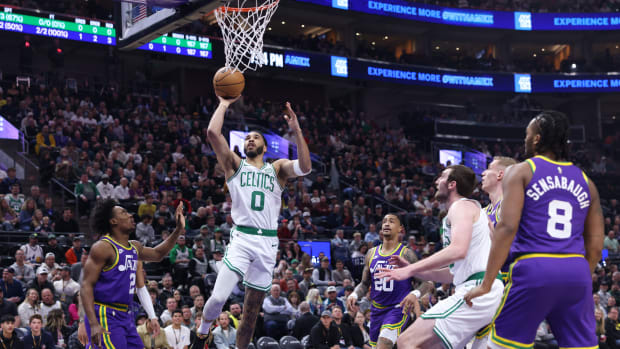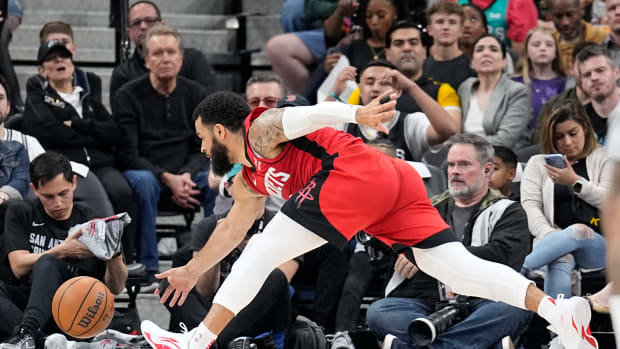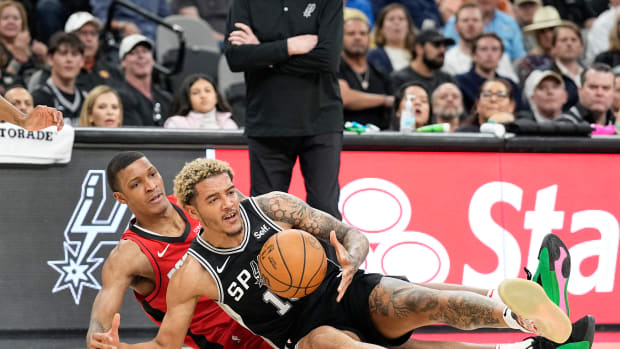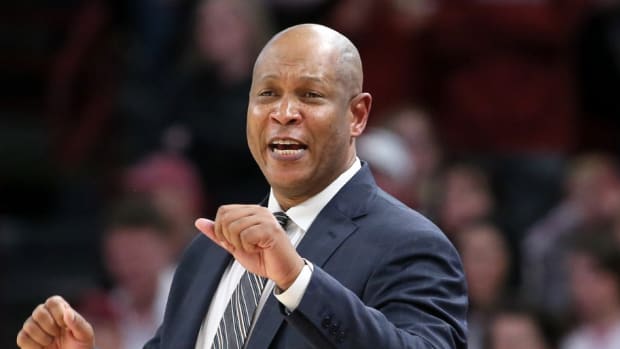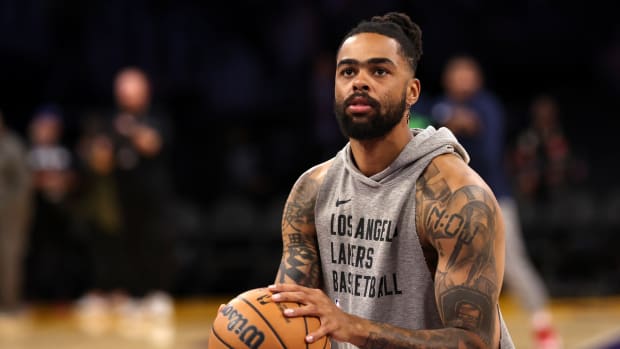
How Dame-Time Was Born
Welcome to the Morning Shootaround, where every weekday you’ll get a fresh, topical column from one of SI.com’s NBA writers: Howard Beck on Mondays, Chris Mannix on Tuesdays, Michael Pina on Wednesdays, Chris Herring on Thursdays and Rohan Nadkarni on Fridays.
The most striking thing about the pandemonium that swept through Portland’s Moda Center on an April night in 2019 was that the man who sparked the happy mayhem did not participate in it.
Damian Lillard stood stoic, indifferent to it all. It’s there on tape, and in the iconic snapshot that followed his 37-foot, buzzer-beating, series-clinching shot to beat the Thunder in the first round of the playoffs.
Trail Blazers players and fans are whooping, hopping, shrieking, smiling, reveling. And there, in the eye of the storm, is Lillard—mouth closed, eyes staring ahead, unmoved, impassive, immune.
Dame Lillard, as the NBA has learned over nine seasons, does drama. He does breathless comebacks and breathtaking shots. He provides endless thrills. He did so again Saturday, leading the Blazers to an upset in Game 1 of their first-round series against the Nuggets. But Dame Lillard does not do pandemonium. He’ll leave that to others.
You might logically conclude it’s because he’s hit so many of these shots before. That he’s grown numb to it. Or that it’s because Lillard is just one cool cat. That he’s wired this way. The term “Dame-Time” is ubiquitous for a reason. There’s some truth to all of it. But none of that truly explains it.
No, you have to go back to the start, back about 15 years on the Damian Lillard highlight reel, to a modest high school gym in Santa Clara, Calif., to the very first game-winner Lillard ever hit—and a different sort of mayhem that followed.
“I think that's why I react so calm to things now when I do something, or something big happens,” Lillard says. “Because that experience damn near traumatized me a little bit.”
The details of that day have become hazy. Even the year.
Lillard, now 30, thinks he was 13 years old at the time. His friend and former teammate PJ Taylor says they were 15. They were playing for the Oakland Rebels, an AAU team, at a tournament held over Memorial Day weekend. Lillard’s coaches say it was the “Rumble in the Bay.” Lillard thinks it was the “Little Big Time” tournament. The game was at Santa Clara University, say the coaches. No, it was an auxiliary gym at a nearby high school, Lillard says.
There’s no film of the game, at least that anyone is aware of. The iPhone (and its clones) had not yet been invented. This was a time before every moment of every kid’s life was recorded, before every teenage hotshot could broadcast every highlight on Instagram (which didn’t debut until 2010).
Lillard was no star then—just a “long, lanky, skinny” kid (in his own words) standing around 5' 9". But he was already a solid shooter and “our best scorer, for sure,” says longtime Rebels head coach Raymond Young.
“We didn’t really label them dudes as stars like that, to be honest with you,” Young says. “It was just a good group of guys. I don't think he was [a star] at that time.”
The Rebels were a younger team, playing up a division against the varsity that weekend. Their opponent, the Bay Area Magic, featured several college-bound players and would be bigger and stronger. Lillard’s team came in with a chip on its collective shoulder.
“We was some Oakland kids, man,” Lillard says. “We didn't go into none of those games like worried or scared or nothing like that. We was almost probably closer to delusional—like we thought we were supposed to beat everybody.”
The tournament’s main attraction was a flashy, older teen on another team from Phoenix named Jerryd Bayless, who would go on to star at Arizona and become the 11th pick of the 2008 draft.
The buzz surrounding Bayless added another element. The Rebels never faced his team, but they did go watch him play during the tournament.
“Jerryd Bayless was getting all this hype,” says Damon Jones, an assistant coach for the Rebels and one of Lillard’s early mentors. “We’re sitting around the gym, and the kids are feeling like they're just as good as him. … Somebody mentioned it, like, 'Man, he ain't all that good. He ain't all that!’ ”
Lillard, in particular, was gunning for Bayless, Taylor recalls.
“He’s like, 'Man, I can get this cat. I can play with this dude,’” he says. “He’s soaking it in, like, 'I’m coming for that spot.’ ”
Facing the Magic, the Rebels were just trying to put themselves on the map.
“It was an important game,” Taylor says, “because we were coming together that summer. We put some pieces together with our team.”
A win would put the Rebels in the tournament semifinals. A loss would drop them to the consolation bracket. They promptly fell behind by double digits—18 points in the first half, in Lillard’s recollection. “Just whooping us,” he says.
“I actually thought the game was over, to be honest with you,” Young says, laughing.
The fairy-tale version of this story would have Lillard leading a furious second-half comeback and nailing the game-winner. It didn’t quite happen that way. The Rebels did steadily chip away at the deficit, but it was more of a group effort, they all say. Lillard played his part, with some timely baskets and furious full-court defense against the Magic’s top scorer.
“They had this one dude that was scoring a lot of points, and I remember I guarded him,” Lillard says. “Me and PJ, we would start to pick people up full-court, double-teaming and all kind of stuff like that.”
With less than a minute to play, the Rebels had knocked the deficit down to two. It was Dame-Time—junior high edition.
“I get a steal,” Lillard says. “I pass the ball. One of my teammates is open. He missed it. I got the rebound.”
From here, the details are hazy again. Lillard says he grabbed the rebound just outside the paint, then dribbled to the corner—“the right corner.” Taylor thinks he sprinted out near the top of the arc—“between the wing and the top of the key.”
What happened next is not in dispute. Lillard composed himself behind the three-point line, loaded up his shot and let it fly.
“You could just see it in his eyes, like how he plays today,” Taylor says. “Calm, cool, collected, like he already made the shot before he took the shot.”
It swished with about two seconds remaining, drilled it. Rebels lead by one.
“We thought we had won the game,” Jones says, prompting Young to chime in: “We thought the game was over.”
Then they noticed something else: Young Dame Lillard, long, lanky and skinny, whooping it up on the court … with his red, white and baby-blue Rebels jersey in his hand. Followed by the piercing screech of a referee’s whistle.
Jones, the more excitable of the two coaches, came bounding toward Lillard, bellowing.
“Put your f------ jersey on! Put your jersey on! You don't take your jersey off!' ”
“And I just remember trying to hurry up and put it back on,” Lillard says.
Too late. A technical foul had been called: two free throws, plus possession for the Magic. Now it was Young who became unglued.
“I said, 'Technical foul?! What are you talking about?!' ” Young recalls yelling at the referee. “And he said, 'He pulled his jersey off.' I'm like, 'Dude, the game is over! It's two seconds!’ ”
The Magic hit both free throws. The Rebels lost by one.
Lillard’s burst of joy had turned to despair. “Damn, I blew it,” he remembers thinking.
“It was a baaad feeling, man,” Lillard says today, his voice low. “We wasn't one of the most popular teams or nothing, so it wasn't like a full gym, but like parents were there. Parents of the other team, some kids, whatever. I just remember I felt embarrassed.”
In the locker room afterward, Lillard apologized to his teammates. Young urged everyone to view it as a life lesson, a “teachable moment.”
“You never know who's watching, who's paying attention,” Young says he told Lillard. “We don't handle ourselves like this. ... And you just got to stay in the moment. When you do things like that, it kind of takes away from your team, and all the hard work we put into it together as a team.”
There was still a consolation game to play, which meant the Rebels had to hang around and keep answering questions from friends and rival teams about the loss.
“And then we would have to tell the story over and over and over,” Lillard says. “I was sitting [there] like, 'Damn, we need to just hurry up and play another game.’ ”
Lillard says he can’t recall a single other thing from that tournament.
“I moved on from it pretty quick,” he says.
Jones did his best to frame the lesson constructively.
“I let him know that I wasn't mad that we lost a game; I was more disappointed on how we lost,” Young says. “And just assured him that this wouldn't be his last clutch basket.”
There are too many to count now. Floaters, layups, deep threes, deeper threes, college, pros, regular season, playoffs. Game-tying shots. Game-winning shots. Momentum-turners.
Young says Lillard hit several clutch shots over the years for the Rebels, and routinely drilled them in team scrimmages. Lillard says his first true game-winner came in 11th grade, at Oakland High School.
You can even catch a grainy glimpse of one of the earliest Dame-Time moments, in a new Adidas commercial: Lillard, then a senior at Oakland High, pulling up from 30 feet for a game-tying shot.
But his first game-winner—the one that didn’t actually result in a victory—just might be the most important. It’s more than a charming, if emotionally fraught, memory. It was an important early lesson.
“Sometimes, you make mistakes,” Lillard says. “Sometimes, things are not gonna go your way. You got to be able to bounce back from it, you know? You got to be able to accept responsibility when you do something that causes pain or hurts other people. And I cost my team that day, and I had to live with it.”
So the next time you see the footage from that game-winner in April 2019, or the one Lillard hit against the Rockets, or the one against the Bulls, or the Suns, or the Warriors, or the Lakers, don’t watch the ball, or the celebration on the bench, or the revelry in the stands; watch Lillard’s face. That serenity you see now is rooted in one brief but costly moment of uncontrolled jubilation.
“Today when I make game-winners, people always ask me, like, 'How are you so calm? How are you just so poised when you make these big shots?' ” Lillard says. “And I honestly feel like it comes from that. I honestly feel like because of that experience, I'm much more reserved in my reaction and celebrations to when I make like a big shot or do something like that.”
YouTube is filled with Lillard’s greatest exploits in college and the NBA. But there’s no known record of that tangled moment back in Santa Clara, some 15 years ago, where a bare-chested Lillard lost a game, just a split-second after winning it.
“If there was, I'd pay them for it,” Lillard says. “Just so I could see, like: 'Damn, this really happened.’ ”
More NBA:
• How the Jazz Turned Into a Serious Threat
• NBA's Superfans Are Ready for the Playoffs
• What Happened to Coach-Star Relationships?
• NBA Playoffs: Who Needs a Legacy Bump?































